Tiwa Savage 49-99 EXPLAINED. Everything You Missed.
What did the whole thing mean?

What did that whole thing mean?
We're about to go deep and dissect one of my favorite music videos from last year, 49-99 by Nigerian superstar, Tiwa Savage.
It's one of those videos that people always ask: What is the meaning of 49-99? What did that music video symbolize? What is the 49-99 meaning?
On the surface, the music video for 49-99 looks like a beautiful collection of shots and scenes that highlight dark-skinned black bodies and showcases beautiful costumes and set pieces. But there's more to this music video.
It is littered with symbolism and yes, there is a story line.
If you're as interested in these kinds of things as I am, then be sure to like and follow me on my Facebook page so you don't miss out on any new interesting stories, lists, and articles that I post every single day. Also, let me know which music video you'll like to see me explain next.
The Song.
Before I jump into breaking down the music video, let me start by telling you how Tiwa Savage herself explained the song and what it means. Tiwa said about 49-99:
The song encourages the young to put down the sense of inheritance and work for what they desire in life, for a better tomorrow. We can’t sit on our old glories and expect things to change for the better.
49-99 also addresses some political leaders who, instead of focusing on the growth of a nation, are there just for the money and having affairs with underage girls – while the citizenry is hustling hard to make a daily living.
I wanted my first global single to have a message that we are suffering and smiling, and music is a powerful tool. I wanted a title which could be a conversation starter like 49 people sitting and 99 people standing… like we’re suffering and smiling.
Now, what about that music video? What did it all mean?
Let's dive right into that now!
Opening Sequence.

The first shot of the 49-99 music video showcases a man holding a snake and reciting an incantation to the beat of the song.
This is followed by men paying for and participating in a wrestling match.

Which is then quickly followed by men gambling/playing board games.

While all this is happening, Tiwa Savage stands surrounded by body guards watching all over the chaos happening unphased.

This is a very important sequence.
This entire sequence depicts the disparity between the rich and the poor, the people with power and those without. Notice the distinction between the men standing with Tiwa vs the other men in the sequence. The men in the sequence don't have shirts (symbolic for them being poor), while the men around Tiwa are fully clothed body guards.
The different men are examples of ways the poor are trying to make money. The first man (the snake-charmer) is representative of people who practice divination. Juju priests, witch doctors, etc.
The men wrestling is just that: men wrestling, a common sport in rural Nigeria.
The men playing board games and gambling. Representative of just that: draft players, gamblers, and people who participate in betting.
While these poorer men fight themselves and cheat themselves, the rich (Tiwa and her camp) stand and watch unphased by all of the chaos. She is protected. Despite all of the rowdiness and craziness going on, she's in no real danger. She's only here to watch.
Why The Monkey?
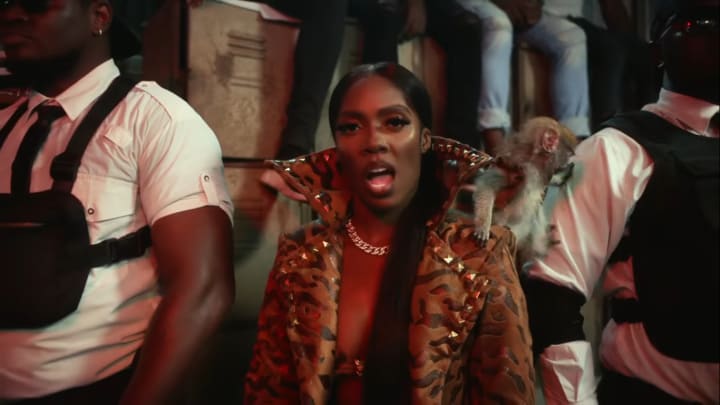
On Tiwa's shoulder is a monkey. At first, the monkey watches the chaos just like Tiwa and the men do, but unlike Tiwa and her men, the monkey cannot stand the chaos and so it runs away. What this means is pretty clear: even animals can't stand to watch the way we as humans treat ourselves, but us human beings are very comfortable with watching the chaos.
The Tailoring Sequence and Women In Blue.
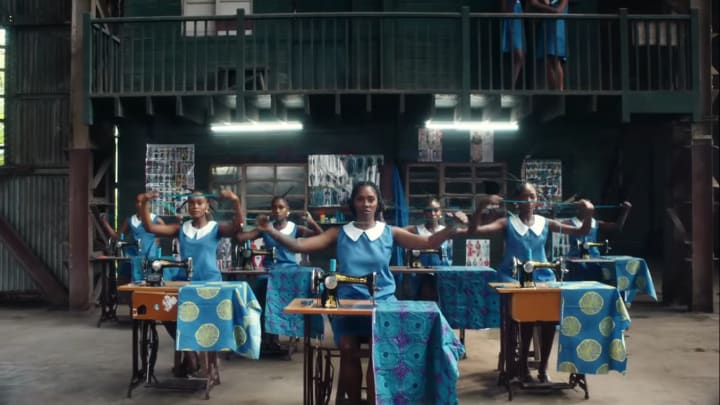
There are so many layers to this, so I'm going to break it down as best as I can.
There are 2 things of note here.
On one hand, we have the very obvious meaning of what is going on here. These are tailors at work hustling for their money. Simple as that.
Now, on the other hand and this isn't as obvious, we keep seeing a repeating sequence throughout the video. In fact, it is so important that it is how the video ultimately ends.
It is this visual of Tiwa and the girls in front of a blue screen, but the blue screen is in the middle of their tailoring shed.

This is very symbolic and is necessary to understand in order to fully understand what is going on throughout the video. Let me explain it.
These women are tailors. They're not rich. They're struggling.
Yet, they are being used as a means to sell commercial products. To sell an image.
Up close, the pictures of the women against the backdrop are beauty shots.
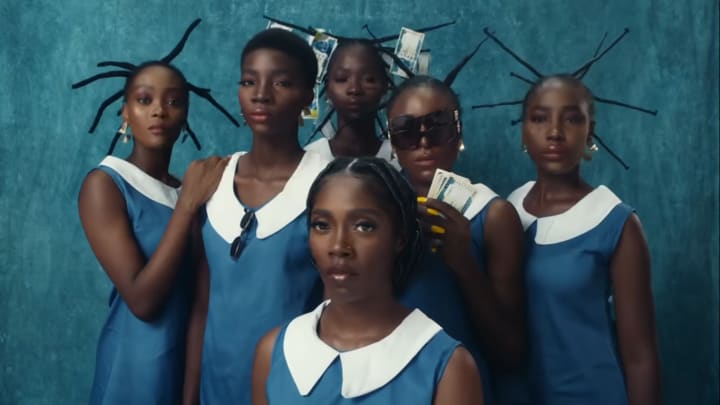
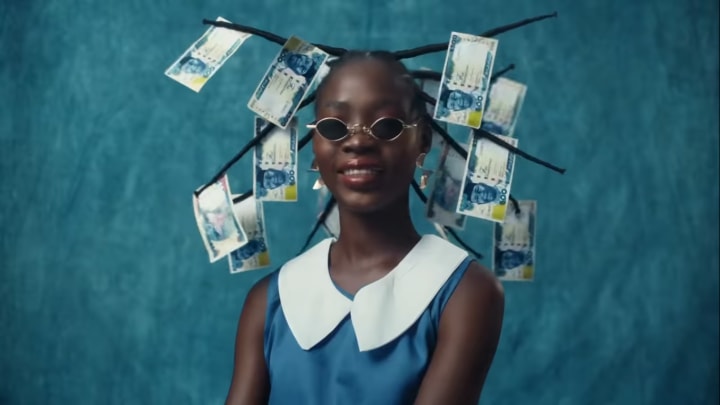
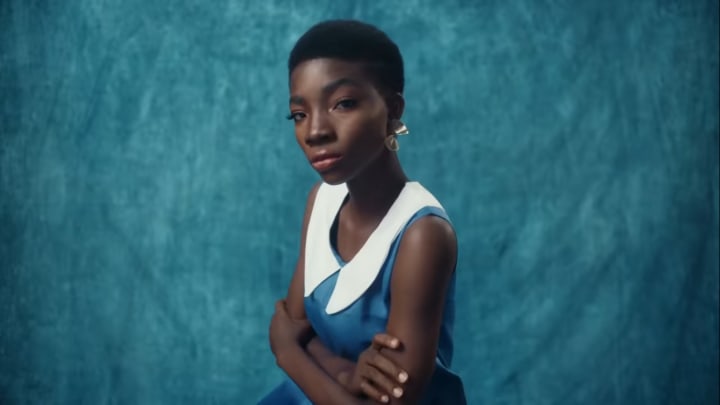


These are beauty shots. Nice, retouched, commercially enticing. We're seeing a girl smiling with money in her hair. We're seeing these beautiful glamorous images of these women with beautiful makeup, counting money with 2 eyeglasses on, etc.
What does this mean?
It's a depiction of exploitation. Using people who are not rich themselves to sell products that promote a rich lifestyle and image.
In fact, this is not the only time we see this kind of image. It comes up again in these shots:
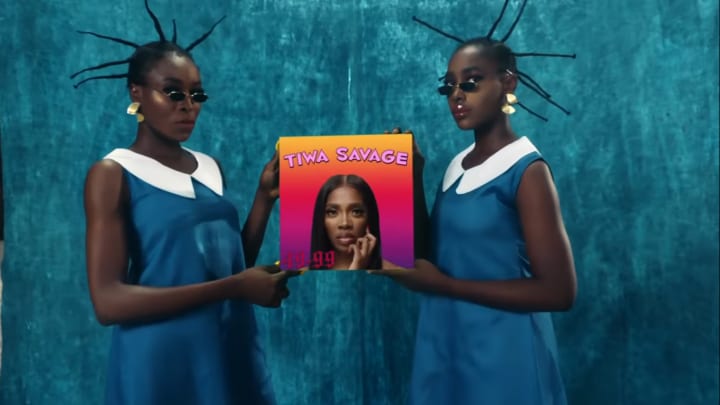

The girls are selling the new Tiwa Savage record. Dancing for Tiwa. Being used as props to push the agenda and products of rich people when they themselves are by no means rich.
It is the exploitation of the lower class by the upper class to move the market.
But then things take a turn!
Taking The Power.
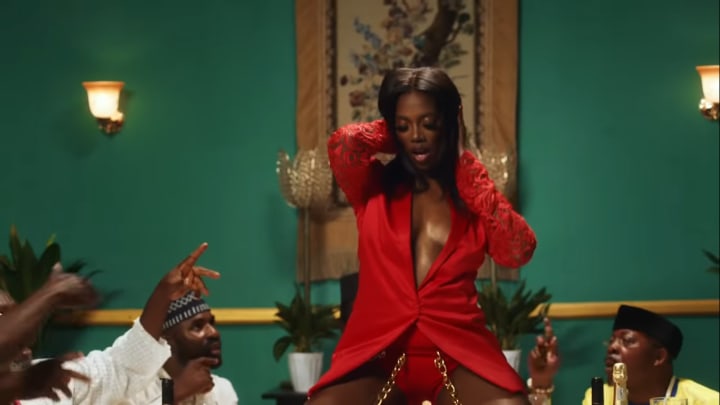
After being exploited, the next scene we see is of a very different Tiwa than we had seen in the tailoring shed. She's a lady in red which is historically symbolic for a prostitute. She's a temptress, a dancer.
And the men cannot get enough of her. They're drooling over her, taking her pictures, losing their minds over this woman dancing on their table.

They toast to her, they're in awe of her.

Meanwhile as this scene is going on, there is another sequence that is slowly being weaved in.
This time, we're seeing the tailors now in a very different light. They're wearing biking gear, sitting comfortably on high power motorcycles. It's a much different image from what we had seen before.

This is a foreshadowing of what's to come. We'll get there soon.
Anyways, Tiwa is dancing on the men's table, they're having a filled day, and then we see this very important image.
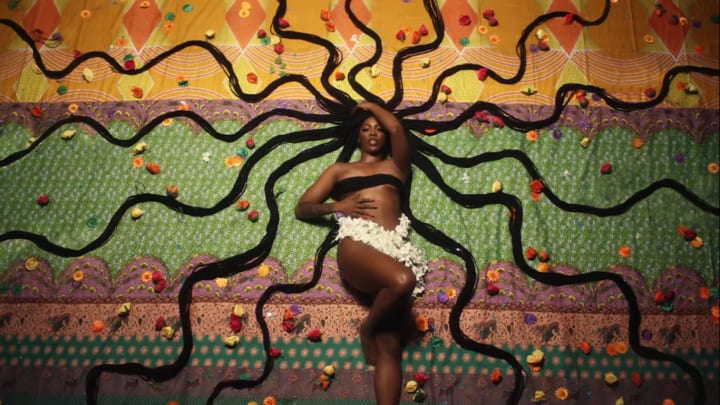
Historically, and now in popular culture, every time a woman is depicted in this way: long hair wild and about as though she has snakes coming out of her head, it is a reference to the Greek goddess, Medusa, and the symbolism that comes with that.

Medusa has historically been a representation of female rage. A woman wronged who has become angry and is now seeking revenge. That is what the Medusa is representative of.
With this scene in 49-99, it represents the same thing. A woman angry. A woman mistreated. A woman who is out for revenge.
And then, the reckoning happens.
Final Reckoning and Power Taken.

In the final scenes of 49-99, we see what everything has been leading up to.
Tiwa has danced on the table, and while the men were enjoying her movements, she was busy plotting their demise.
At the end, she's poisoned them all and now, Tiwa sits comfortably on the table biting into an apple.

In another scene, we see Tiwa wearing a top hat, historically worn by men in power: a symbol of the upper class.
She has taken back the power and now dances arms raised with the women around her on top of a molue bus (what the song is in reference to).
For more context on what a molue bus is and what it means in reference to 49-99, this is what Tiwa said:
For those who are not Nigerian, we have these transit buses, which we call a ‘molue’ and it has 49 seats. So instead of it to have 49 people to commute to work and back, you have 49 people sitting and double that standing, hanging… That’s just a reflection of the economy and the imbalance with the rich getting richer and the poor getting poorer
In some more final images, we see Tiwa standing with power on top of the molue bus.
We also see another image of all those men in the beginning who were distracted by their gambling and wrestling, side by side with Tiwa staring ferociously into the camera.
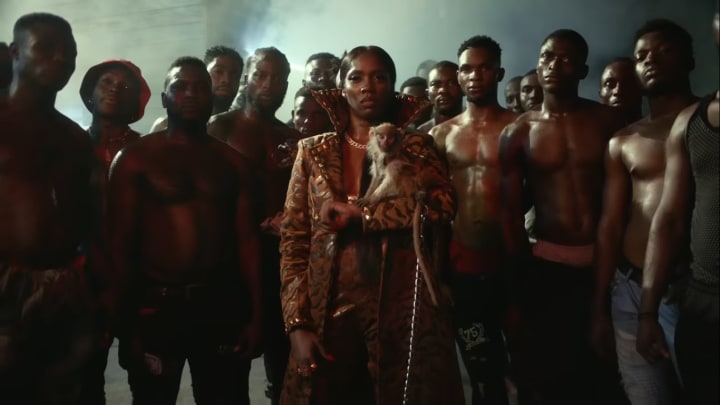
They're now awoken. No longer distracted. The monkey has returned once more, looking into the camera as well. This is very powerful.
Finally, we see Tiwa hands raised with all her girls on motorcyles rocking expensive gear.

An ultimate triumph. She's risen against the exploitation and she's fought back, and she has won. Not just for herself but for all her girls and for everyone at the bottom.
A total triumph.
That unfortunately hasn't yet occurred, because by the end of the video we see that Tiwa and her girls are still in that tailor shed, still being exploited.
The dark reality of where we as a people still currently are.

That's All!
Did you know all this about the 49-99 music video? Are you more impressed by the visuals now that you know what it all means? If so, I'd love to hear your thoughts, as well as which music video you'll like me to explain next.
Don't forget to like and follow me on Facebook so you don't miss out on any new and interesting articles just like this one. I post every single day.
To read other interesting stories I know you'll love, click here.
Until next time, have a wonderful rest of your day!
About the Creator
Jide Okonjo
I have ONE account and MANY interests. My page is a creative hodgepodge of:
🇳🇬 Nigerian news stories for my dedicated Nigerian readers.
🎥 Movie and music recommendations, listicles, and critiques
📀 Op-eds, editorial features, fiction






Comments
There are no comments for this story
Be the first to respond and start the conversation.